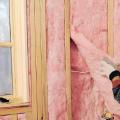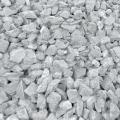Three simple options for insulating garage doors with modern thermal insulators
Every car enthusiast has repeatedly asked himself the question of how to insulate garage walls and doors so that the problem is solved efficiently and for a long time. This is felt especially acutely by owners whose garages are made entirely of metal. Corrosion here spares nothing, including the car. Since gates are often the main source of cold and dampness, they need to be insulated first.
The construction industry has a large number of types of thermal protection that can reliably retain heat in the garage. In our case, the following four materials will be of interest:
- Polyurethane foam (PPU);
- Expanded polystyrene or foam boards;
- Mineral or stone wool;
- Foamed polyethylene.
Very often, the main criterion for choosing a heat insulator is its cost and quality. This approach is correct and completely justified from an economic point of view. However, you should not neglect the basic characteristics of insulation. If one of them is cheaper, this does not mean that it is bad. It just has its own individual properties, which must be taken into account during installation.
Foam plastic
 Insulating garage doors with polystyrene panels is the most common and widespread method. In addition to the fact that the material is inexpensive and lightweight, it has the following advantages:
Insulating garage doors with polystyrene panels is the most common and widespread method. In addition to the fact that the material is inexpensive and lightweight, it has the following advantages:
- easy to cut;
- moisture resistant;
- not susceptible to mold and fungi;
- has a long service life.
Recently, fire retardant has been added to many brands of polystyrene foam, which has given it a high degree of fire safety.
Polyurethane foam

The technological qualities of this material allow for quick insulation. Working with it does not require professional training or special handling skills. It is enough to strictly follow the rules written on the aerosol can so that everything works out the first time. The advantages of this substance include:
- fire resistance;
- low weight with high strength;
- low thermal conductivity and resistance to temperature fluctuations;
- chemical and biological immunity to various reagents, mold and fungi.
All that remains is to add a long service life (up to 70 years), safety for health and the ability to form a monolithic layer that fills all the cracks and cavities on the surface. Polyurethane foam is the most effective material. It has one drawback: the high price. But the insulation is excellent.
Mineral wool
 Cotton wool is a fibrous material. Produced by processing basalt rocks or glass production waste. It is produced in the form of slabs and rolls. The material has absolute fire resistance, is inert to aggressive environments, retains heat well, is non-toxic and is an environmentally friendly product.
Cotton wool is a fibrous material. Produced by processing basalt rocks or glass production waste. It is produced in the form of slabs and rolls. The material has absolute fire resistance, is inert to aggressive environments, retains heat well, is non-toxic and is an environmentally friendly product.
Mineral wool is cheaper than polyurethane foam, but its heat-insulating properties are no lower. The only negative is its ability to condense moisture. Therefore, you should always insulate garage doors with cotton wool using steam and waterproofing films.
After you have made a choice in favor of one or another insulation, you need to calculate how much material will be used for insulation work. To do this, take measurements of the gate and determine its area, and also purchase related consumables that are used in the installation technology of a specific heat insulator.
Foamed polyethylene
This material is an elastic polyethylene sheet with many voids. Available in different thicknesses, there are brands covered with aluminum foil on one side. Foamed polyethylene is more expensive than polystyrene foam, but has almost the same thermal conductivity. In addition, it is difficult to glue and requires special glue, so it is not practical for insulating garage doors.
Thermal insulation using polyurethane foam

Thermal insulation with polyurethane foam is carried out by spraying. In order for the layer to be of high quality, it is necessary to adhere to a clear sequence in work:
- Pay due attention to the surface. It should be degreased and cleaned of dirt and traces of corrosion.
- Before applying polyurethane foam, make sure that the door surface temperature is not lower than +10 degrees.
- To make the process of adhesion and polymerization go faster, the surface is slightly moistened.
- Using an aerosol can, the material is sprayed in a layer of about 60 mm thickness.
- Excess and uneven insulation is carefully cut off with a knife.
- For final finishing, plaster, paint and other facing materials are used.
Polyurethane foam after hardening is a harmless substance, but still, spraying work is recommended to be carried out in protective clothing, a respirator and goggles.


Foam-based thermal insulation
Despite the fact that there are several designs of garage doors, the principle of insulating them with sheet polystyrene foam is the same for all. Therefore, the step-by-step installation instructions are general and acceptable for swing, sliding and overhead gates.

First of all, it is necessary to clean the insulated surface from rust and old paint. Then the metal is primed. Then everything is done in the following sequence:
- First, the sheathing is attached. It is made from wooden slats so that the distances between them correspond to the dimensions of the foam sheet. The sheet should be trimmed and easily inserted between the slats, forming a gap of 1.5-2 cm with them.
- After this, the insulation is smeared with glue, inserted into a cell of the wooden frame and pressed, and the gaps between the slats and the end of the sheet are filled with foam. As it expands, it expands the structure and gives it additional strength.
- To protect the insulating layer from mechanical damage, use oriented strand board, boards, and plywood. They are attached with self-tapping screws to the sheathing, primed and painted.

When insulating garage doors, you can use various brands of glue. The main requirement for them is moisture resistance and high adhesion. Liquid nails are better suited for fastening the sheathing. As for the thickness of the foam, its recommended value of 60 cm can be obtained from thinner sheets, having previously glued them together.

Some citizens glue foam plastic to metal without lathing. At first glance, this significantly speeds up the process, but the surface of the foam is very fragile and will quickly crumble without protection. Without sheathing, there is nothing to attach clapboard, plywood or other facing material to.
Mineral wool insulation
 As in the case of insulation with polystyrene foam, when sheathing with mineral wool, a sheathing is installed. The surface of the gate is prepared in a similar way. Then proceed as follows:
As in the case of insulation with polystyrene foam, when sheathing with mineral wool, a sheathing is installed. The surface of the gate is prepared in a similar way. Then proceed as follows:
- A layer of basalt wool is pre-wrapped in a vapor barrier material, which is covered on both sides with aluminum film. This prevents the formation of condensation and reliably protects the metal from corrosion.
- Then the finished block or roll is treated with an antifungal agent, inserted between the slats of a wooden frame, pressed against the gate sheet and secured with dowel nails.
- After covering the entire surface with cotton wool, the remaining gaps, joints and cracks are blown in with polyurethane foam.
Gate finishing
You can give an aesthetic appearance to the insulated surface using any finishing material. In this case, plastic siding, galvanized iron, lining, plywood, OSB, laminate (pictured), etc. are suitable. It is attached to the sheathing slats. Then the joints are sealed with silicone-based sealant. If necessary, apply primer and paint.

To all the recommendations on how to make a garage door resistant to the penetration of cold and moisture, it is necessary to add one significant point. It often happens that the joints between the gate and the wall are left without insulation, and the mutual contact of the leaves has a gap. In this case, rubber tape with heat-shielding properties is used, and the joints are insulated with a self-adhesive rubber seal of optimal thickness.
 Construction materials and list of works
Construction materials and list of works Proper insulation of a wooden ceiling in a private house
Proper insulation of a wooden ceiling in a private house What types of crushed stone are there?
What types of crushed stone are there?